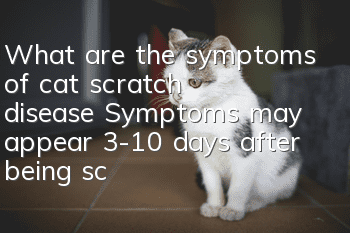What are the symptoms of cat scratch disease? Symptoms may appear 3-10 days after being scratched by a cat

People may develop cat-scratch disease after being scratched by a cat. So what is cat-scratch disease? The so-called cat-scratch disease is an infection caused by Bartonella henselae. It is a A small, pleomorphic Gram-negative bacilli that can be seen under a microscope.
When patients become ill, they may have symptoms of swollen lymph nodes and fever. Cat-scratch disease is prevalent around the world every year, with more than 40,000 cases, mostly teenagers and children. There is no difference between men and women. It is more common in warm seasons than cold seasons. .
About 70% of patients with the above symptoms have records of being scratched by cats. Within two weeks of being scratched by a cat, the lymph nodes near the inoculation wound will become swollen and soft to the touch. These swollen lymph nodes are usually found in the armpits, neck, and collarbones. The diameter of the swollen lymph nodes ranges from 1 to 5 centimeters, and are accompanied by an area of redness and swelling around them. This redness and swelling of the lymph nodes can last for several months.
Typical clinical features are primary skin lesions and lymphadenopathy, which are generally benign and self-limiting. However, a small number of patients may develop severe systemic damage, such as granulomatous hepatitis, hepatosplenomegaly, neuritis, and meningoencephalitis, and the entire course of the disease lasts 1 to 4 months.
What are the symptoms of cat scratch disease?
Cat scratch disease has a certain incubation period, and symptoms may appear 3-10 days after being scratched. Under normal circumstances, the entire course of the disease is within 4 months. Of course, there are special circumstances where the duration may be longer. So what are the characteristics of cat scratch disease? Let’s give a brief explanation.
Whole body performance
Typical primary lesions are erythematous, crusted and papules (rarely purulent) with a diameter of 2 to 6 mm. Local lymphadenopathy develops within 2 weeks, often unilaterally, on the scratched side (affecting axillary, superior trochlear, submandibular, cervical or inguinal lymph nodes). The lymph nodes are firm and soft at first, but then become choppy and may leak fluid and form fistulas. Patients' symptoms of fever, fatigue, headache, anorexia and lymphadenopathy may appear at the same time.
Eye lesions
Leber neuroretinitis, Leber first described this type of eye disease in 1916, manifesting as vision loss, optic disc edema and macular starburst exudation, and named it neuroretinitis.
Parinaud ophthalmic gland syndrome
The main manifestations are the triad of unilateral follicular conjunctivitis, ipsilateral preauricular or submandibular lymphadenopathy, and low-grade fever. The main symptoms are conjunctival redness, congestion and discharge. This syndrome can be caused by infection with a variety of pathogenic microorganisms, of which cat-scratch disease is the most common cause.
Uveitis
In patients with intermedial uveitis, the ocular manifestations are leakage around the retinal blood vessels in the middle and periphery of the fundus and spreading to the pars plana of the ciliary body., cells appeared in the vitreous body, and there were no abnormalities in the optic disc and macula.
Retinopathy
The main manifestation is retinal vasculitis, and the fundus manifests as single-focal multifocal retinal vascular inflammation, which may or may not be accompanied by optic neuroretinal inflammation. Gray-white localized infiltrative lesions under the retina may also appear, accompanied by scattered punctate hemorrhages. Other rare manifestations include retinal nodules, serous retinal detachment, retinal branch artery (or vein) occlusion, etc.
Other symptoms
Some patients may experience some uncommon symptoms due to cat scratching: such as ocular gland syndrome, neurological symptoms, brain lesions, acute attacks, neuroretinitis, myelitis, lower body paralysis, cerebral arteritis and liver, Granulomatous disease of the spleen. Other uncommon symptoms include erythematous nodules, myelolytic lesions, and thrombocytopenic purpura.
- A cat will die if it urinates for a few days
- Should you deworm yourself or go to a pet store?
- Are cat teasers harmful to cats?
- What should I do if my cat suffers from chronic gingivitis?
- Cat's nails are cracked with a thin layer
- Cats go crazy after eating mutton
- What does cat moss on a cat’s chin look like?
- Can cats reproduce after abdominal transmission is cured?
- What exactly is the sterilization shot for female cats?
- Can I still eat unopened cat food if it has expired?



